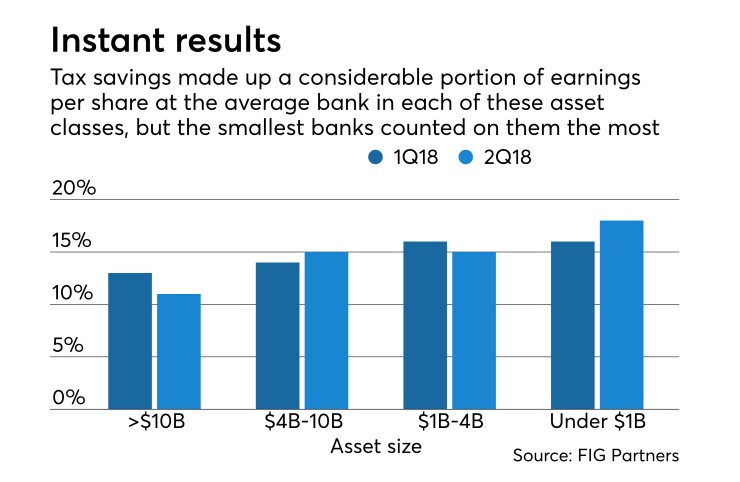For banks, this year’s federal tax cut lived up to billing — it contributed 10%-20% of quarterly earnings at more than half of large banks and masked disappointments in underlying business lines at many institutions.
Regionals fared the best among the large-cap banks. At Fifth Third Bancorp in Cincinnati, 11% of its first-quarter earnings and 21% of second-quarter earnings came from tax savings, according to an analysis by FIG Partners. M&T Bank in Buffalo, N.Y., relied on the tax cut for 21% of profits in the first quarter and 19% in the second quarter.

That said, among four major asset classes, the smallest banks — those under $1 billion of assets —had the highest average: 18%.
But, less than six months from now, bank executives will be asking themselves a tough question: What do we do for an encore?
Next year, after the tax cuts will have been in place for four quarters, year-over-year comparisons will be less favorable. Banks will have to rely more on fundamental growth to fuel strong profit increases.
That will be a challenge for many banks. The second quarter was generally characterized by
“You’ll still have the benefit from taxes [next year]. It’s just that you’re not going to see 2019 income go up over 2018 income without some extraordinary boost,” said Don Musso, president and CEO of the consulting firm FinPro. “There’s going to be winners and losers. Some banks are going to do really well, but a lot of banks are not cutting the mustard, and they’re going to see their income start to tighten.”
Before the tax law change, most banks had effective tax rates of 34% to 35%, said Charles Frago, a principal with the Boston-based accounting firm Wolf & Co. “Then with [President] Trump’s swipe of the pen, it went down to 21%, so you expect a fair amount of increased earnings even if everything else is flat, just due to taxes,” he said.
It’s not easy to distinguish how much of banks’ earnings came from core operations versus the tax breaks, but the estimates offer striking numbers.
FIG’s Chris Marinac compared banks’ first- and second-quarter earnings this year with those in last year’s third quarter. The third quarter is the cleanest pre-tax change comparison, he said, because many banks had to write down their tax deferred assets in the fourth quarter, causing a lot of noise in those results.
He factored in the tax rate they paid in last year’s third quarter, compared it to the tax rates they paid in the first and second quarters this year, and figured out the average tax rate savings and benefit that banks received as a result of lower tax rates.

In the second quarter, banks with over $10 billion of assets saw their tax rates decline an average of 8.8%, and tax savings made up 11% of earnings per share. Banks with assets between $4 billion and $10 billion shaved an average of 9.6% off their tax rates, and tax savings contributed 15% of their per-share earnings.
Banks in the $1billion- to $4 billion-asset category saw their tax rates fall 8.9% and tax savings make up 15% of their EPS. And banks between $150 million to $1 billion of assets had 10.6% lower tax rates and 18% of EPS come from tax savings.
About 10% to 11% of profits in the second quarter (and 10% to 16% in the first quarter) came from tax savings at the big four: JPMorgan Chase, Bank of America, Wells Fargo and Citigroup.
Dozens of midsize and community banks derived anywhere from 5% to 68% of earnings per share from tax savings in the second quarter. Some of the big beneficiaries included People’s United in Bridgeport, Conn., (11%); Bar Harbor Bankshares in Maine (12%) and Flushing Financial in Uniondale, N.Y. (13%); Wintrust Financial in Rosemont, Ill., (15%); and TCF Financial (23%).
Banks will still benefit from the lower tax rate next year, but how they are using that extra cash now matters for their long-term growth potential.
Musso identified three main ways he has seen banks use their tax savings. He figured that roughly a third are giving some of it back to shareholders in the form of higher dividends or stock repurchases, for example. Another third are investing in technology and infrastructure, with an eye toward future competitiveness. And that last third or so are using that money to try to hold onto deposits.
He said those that are investing in technology and infrastructure spending are likeliest to come out as winners next year, although it is hard to discount the importance of holding onto deposits now, too. Marinac offered a similar assessment.
“When we first started talking about this, a lot of folks, myself included, said it would be technology and infrastructure spending, but the reality is, banks are probably going to spend as much on funding as they do on technology,” Marinac said. “Technology is important, don’t get me wrong, but I think the funding side is a bigger deal than we all understood back in December or January.”
Banks might eventually have to rediscover some old skills like tax planning, too.
Frago also said that he doesn’t see many mid-market community banks focusing much on tax planning anymore.
“They got a big tax benefit by doing nothing. You don’t get as much benefit of doing tax planning as you used to,” he said. “I have one client who does a lot, but other than that, most of them are pretty quiet.”





